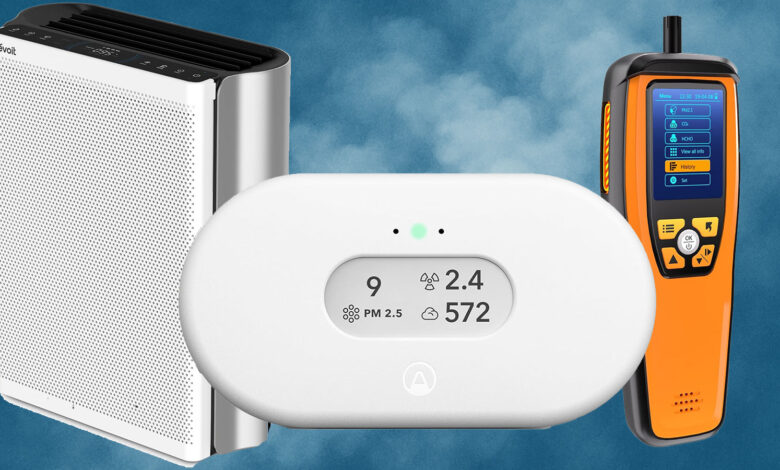How to measure the air quality in your home by yourself and with a pro

Testing your indoor air quality is crucial for maintaining a healthy living environment, especially since indoor air can be three to five times more polluted than outdoor air. With most people spending 90 percent of their time indoors, it’s essential to ensure that the air you breathe is clean and safe. To help you understand why and how to measure air quality, we consulted with a team of experts in the field.
According to Michael Rubino, a mold and air-quality expert, our air quality significantly impacts our overall wellness. He explains that pollutants such as VOCs, mold, bacteria, allergens, pesticides, lead, and other harmful substances can negatively affect our health. Modern construction practices have also contributed to lowering indoor air quality, with buildings being more tightly sealed, limiting airflow and allowing contaminants to accumulate.
Some of the most harmful substances found in indoor air include Benzene, Xylene, and Mycotoxins. Benzene, commonly found in plastic manufacturing and cigarette smoke, can lead to neurological issues, immune system damage, headaches, and even cancer. Xylene, present in paint thinners and solvents, can cause nausea, dizziness, and neurological effects. Mycotoxins, byproducts of mold, can result in serious health issues such as nausea, vomiting, abdominal pain, convulsions, and an increased risk of liver cancer.
Research has also shown that exposure to airborne pollutants can impair lung function, leading to an increased risk of respiratory illnesses. Therefore, testing your indoor air quality is essential for maintaining a healthy living environment.
To test your home’s indoor air quality yourself, Brad Roberson suggests looking out for common warning signs such as musty odors, dust buildup near vents, and symptoms like sneezing, coughing, or headaches. Using a hygrometer to monitor humidity levels between 30 and 50 percent can also help ensure a healthy indoor environment.
One product that can assist in maintaining optimal humidity levels is the Dreo Cool Mist Humidifier, which comes with a hygrometer to measure humidity levels. This ultrasonic top-fill humidifier is suitable for every room in your home, from the nursery to the master bedroom.
In conclusion, testing your indoor air quality is crucial for ensuring a healthy living environment free from harmful pollutants. By being proactive and taking steps to monitor and improve your indoor air quality, you can create a safe and healthy space for you and your family. Indoor air quality is a crucial aspect of maintaining a healthy living environment. Many factors can affect the air quality in your home, including humidity levels, allergens, mold, and volatile organic compounds (VOCs). Lisa Sternfeld, an interior designer and environmental health expert, recommends using affordable at-home testing kits to identify and mitigate these pollutants.
For allergen testing, Sternfeld suggests using at-home kits that can detect common irritants like dust mites, pet dander, and pollen. These kits can provide valuable insights into the airborne allergens present in your home.
Mold testing is also essential, as exposure to mold can lead to various health issues. Home kits for mold spores can help you identify hidden mold growth in your living space. The Mold Test Kit for Home offers three different testing methods, allowing you to test the air, surfaces, or HVAC system for mold.
Volatile organic compounds (VOCs) are chemicals that can off-gas from household products and materials, posing a risk to indoor air quality. VOC testing kits can help you determine if these compounds are present in high concentrations in your home.
For broader monitoring of indoor air quality, Sternfeld recommends using handheld or portable air-quality monitors. These devices can track particulate matter like pollen and smoke particles, carbon dioxide (CO2), and VOCs. The Temtop M2000 2nd Generation air quality monitor is a versatile option for monitoring various pollutants in real-time.
Smart air purifiers, such as the Levoit EverestAir Smart Air Purifier, can automatically detect and capture allergens and pollutants in the air. These devices feature air-quality indicators that change color based on the air quality level, making it easy to monitor and improve indoor air quality.
Consumer-level indoor air-quality monitors, like the Airthings 360 View Plus Air-Quality Monitor, can track VOC levels from common sources like cleaners, paint, and furniture. These monitors can also measure CO2 levels, temperature, and humidity, providing a helpful overview of indoor air quality.
In conclusion, maintaining good indoor air quality is essential for a healthy living environment. By using home testing kits and air-quality monitors, you can identify and address common pollutants to ensure the air in your home is clean and safe to breathe. Indoor air quality is a crucial aspect of maintaining a healthy home environment. Professionals use advanced tools and techniques to assess the air quality in your home, providing you with valuable insights and recommendations. Let’s take a closer look at how professionals test indoor air quality and how it differs from DIY methods.
What professionals test for
Professionals test for a variety of contaminants and factors that can impact indoor air quality, including:
- Particulate Matter (PM1, PM2.5, PM10): Fine particles that can affect lung health.
- Volatile Organic Compounds (VOCs): Off-gassed chemicals from furniture, cleaners, etc.
- Formaldehyde: A common VOC from building materials.
- Mold Spores and Mycotoxins: Biological contaminants that can impact immune system health.
- Carbon Monoxide (CO) & Carbon Dioxide (CO₂): For combustion safety and ventilation.
- Humidity & Temperature: For mold and bacteria prevention.
- Radon Gas: Especially in basements and ground-level homes.
- Bacteria & Actinobacteria: Microbial contamination from water damage.
- Airborne allergens: Pollen, pet dander, and dust mites.
What professionals use
Professionals utilize specialized equipment to conduct thorough indoor air quality assessments, including:
- Laser Particle Counters: For measuring PM levels in real-time.
- VOC Detectors: Using photoionization detection (PID) or flame ionization detection (FID).
- Formaldehyde Detectors: Calibrated to industry standards.
- Petri dish, Surface Sampling, Air Sampling, and The Dust Test: Analyzed in a lab for mold.
- Thermal Imaging Cameras: To identify hidden moisture problems.
- Borescopes & Moisture Meters: For inspecting inside walls and under floors.
- Radon Test Kits (Continuous Monitors or Alpha Track): For long-term exposure.
- CO/CO₂ Monitors: To assess combustion safety and air exchange.
- Lab Analysis: Many samples are sent to accredited labs for further testing.
How that is different from DIY
While DIY indoor air quality monitoring tools are available for consumers, a professional assessment offers a deeper, science-backed analysis of your indoor environment. Professionals can provide pinpointed recommendations based on lab testing and comprehensive data collection. This is particularly useful when investigating health issues or after events like water damage.
On the other hand, DIY assessments are more focused on monitoring trends and maintaining general air quality. While they can be useful for everyday awareness, they may lack the precision and depth needed to identify specific sources of contamination. It’s recommended to start with a DIY assessment and then consult a professional for a more thorough evaluation if needed.
In conclusion, hiring a professional for an indoor air quality assessment can provide you with valuable insights and actionable solutions to improve the air quality in your home. Their expertise and advanced equipment ensure a comprehensive analysis of potential contaminants, helping you create a healthier living environment. The world of technology and innovation is constantly evolving, with new advancements and breakthroughs happening almost daily. From artificial intelligence to virtual reality, the possibilities seem endless. One of the most exciting and potentially life-changing innovations to emerge in recent years is the development of brain-computer interfaces (BCIs).
BCIs are devices that allow for direct communication between the brain and an external device, such as a computer or prosthetic limb. This technology has the potential to revolutionize the way we interact with machines and could have far-reaching implications for a wide range of fields, from medicine to entertainment.
One of the most promising applications of BCIs is in the field of medicine. For individuals with disabilities or injuries that affect their ability to move or communicate, BCIs offer a way to regain some level of independence. For example, BCIs can be used to control prosthetic limbs, allowing amputees to perform tasks that were previously impossible. In addition, BCIs can also be used to help individuals with conditions such as paralysis or locked-in syndrome communicate with others and control their environment.
In addition to its medical applications, BCIs also hold great promise in the field of entertainment and gaming. Imagine being able to control a video game using only your thoughts, or experiencing virtual reality in a way that feels completely immersive and natural. BCIs could also be used to create new forms of interactive storytelling, where the user’s thoughts and emotions can directly influence the outcome of the narrative.
Of course, with any new technology, there are also concerns and ethical considerations to take into account. For example, there are questions about privacy and security when it comes to accessing and interpreting someone’s thoughts and brain activity. There are also concerns about the potential for misuse of this technology, such as using BCIs for mind control or surveillance.
Despite these challenges, the potential benefits of BCIs are too great to ignore. As researchers continue to make advances in this field, we can expect to see even more exciting applications of this technology in the years to come. Whether it’s helping individuals with disabilities lead more independent lives or creating new and immersive forms of entertainment, BCIs have the potential to change the way we interact with the world around us. Cryptocurrency has been a hot topic in the financial world in recent years, with many investors and enthusiasts jumping on the bandwagon to try and capitalize on the potential gains that can be made in this volatile market. However, with the rise in popularity of cryptocurrencies, there has also been an increase in the number of scams and fraudulent schemes targeting unsuspecting individuals looking to invest in digital assets.
One of the most common cryptocurrency scams is the Ponzi scheme, which promises high returns on investment but ultimately pays out returns to earlier investors using the capital of new investors. This unsustainable model eventually collapses when there are not enough new investors to pay out returns to earlier investors, leaving many individuals with significant financial losses.
Another common type of cryptocurrency scam is the pump and dump scheme, where a group of individuals artificially inflate the price of a particular cryptocurrency by spreading false information or engaging in coordinated buying activity. Once the price reaches a peak, the perpetrators sell off their holdings, causing the price to plummet and leaving unsuspecting investors with worthless assets.
In addition to these more traditional scams, there are also a number of phishing scams targeting individuals who use cryptocurrency exchanges or wallets. Phishing scams typically involve sending out fake emails or messages that appear to be from legitimate sources, such as exchanges or wallet providers, in an attempt to steal sensitive information like login credentials or private keys.
To protect themselves from falling victim to cryptocurrency scams, investors should exercise caution and do their due diligence before investing in any digital asset. This includes researching the project behind the cryptocurrency, understanding the technology and market dynamics, and only investing money that they can afford to lose.
Additionally, investors should be wary of any investment opportunity that promises guaranteed returns or seems too good to be true. They should also be cautious of unsolicited messages or emails and avoid clicking on any links or providing sensitive information to unknown sources.
Overall, while the potential for gains in the cryptocurrency market is undeniable, investors must remain vigilant and skeptical of any investment opportunity that comes their way. By taking the necessary precautions and staying informed, individuals can protect themselves from falling victim to cryptocurrency scams and fraudulent schemes.



